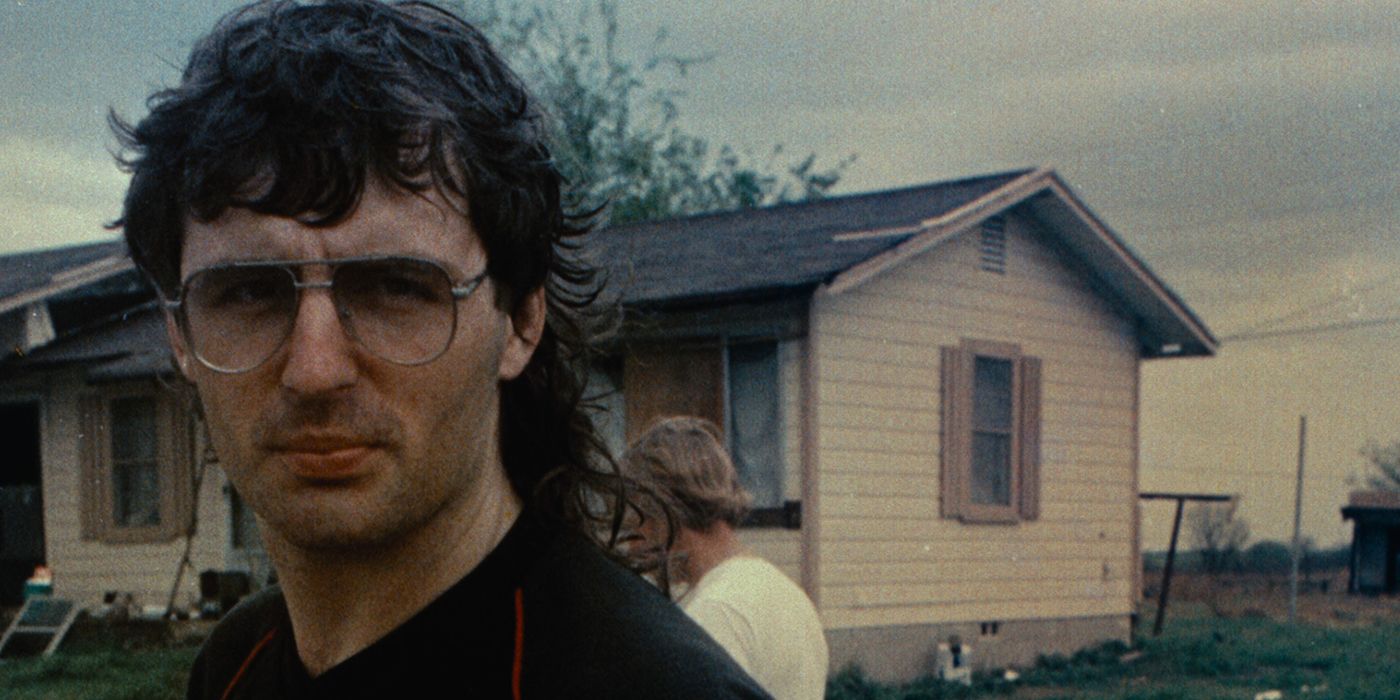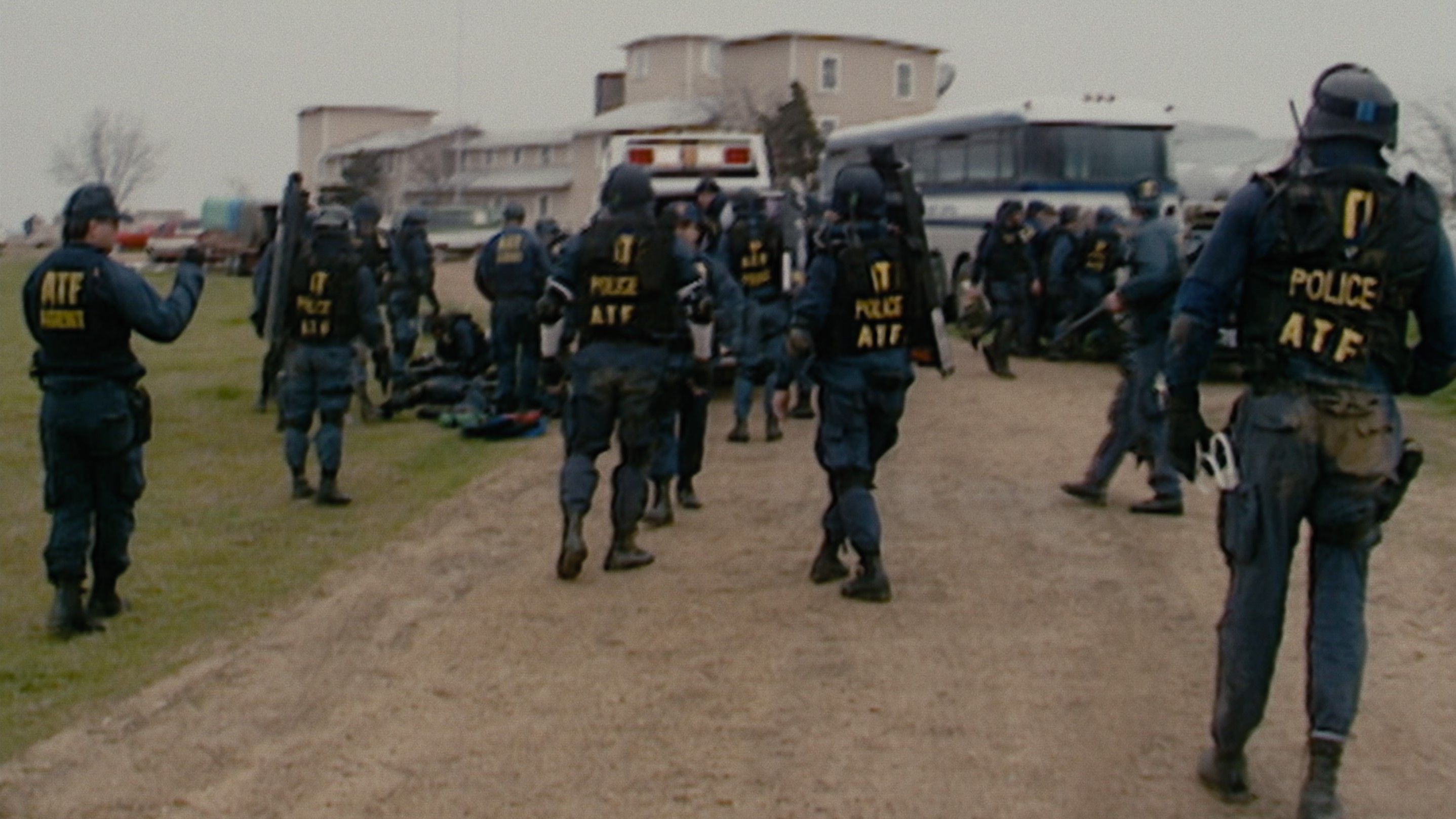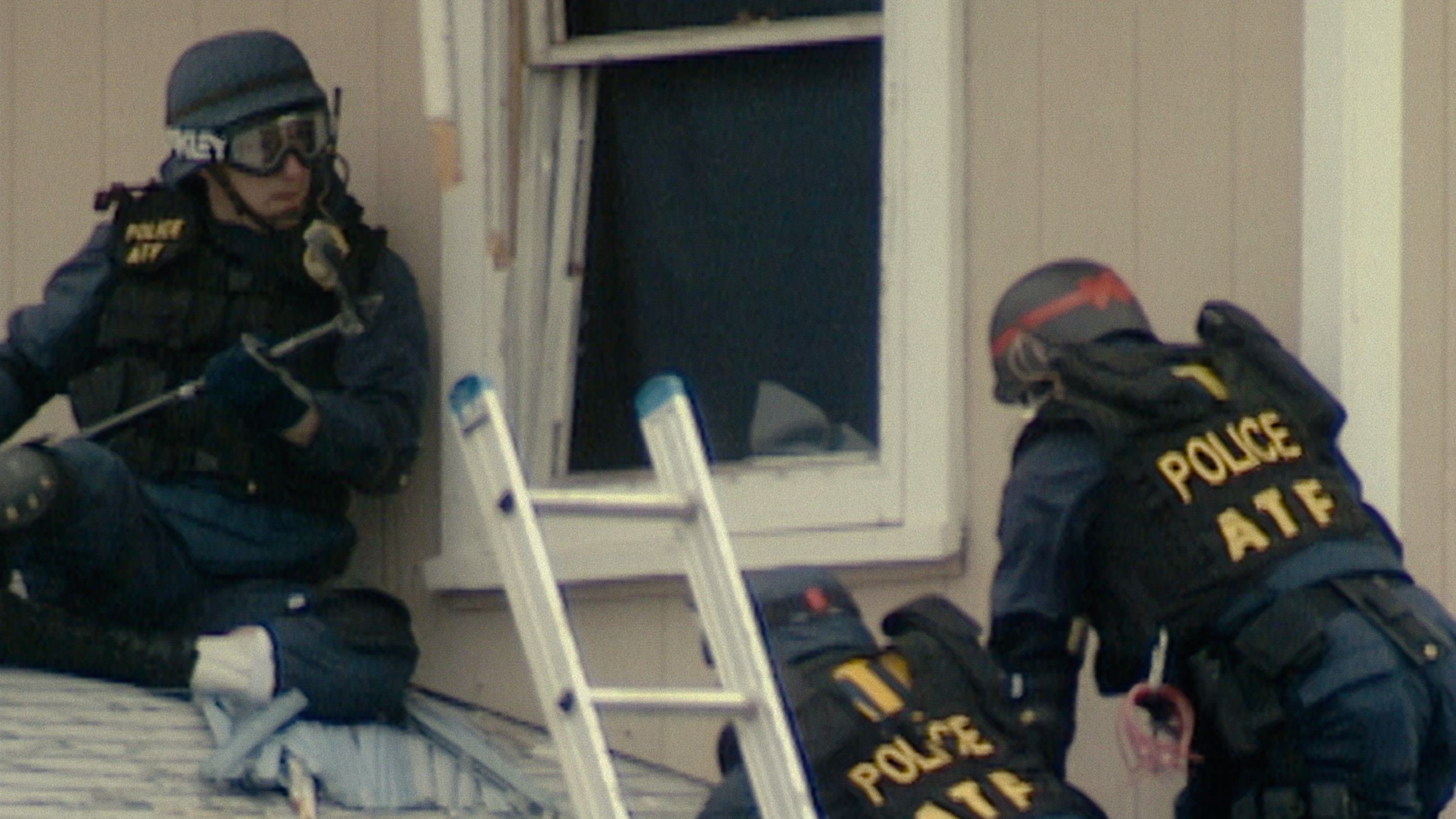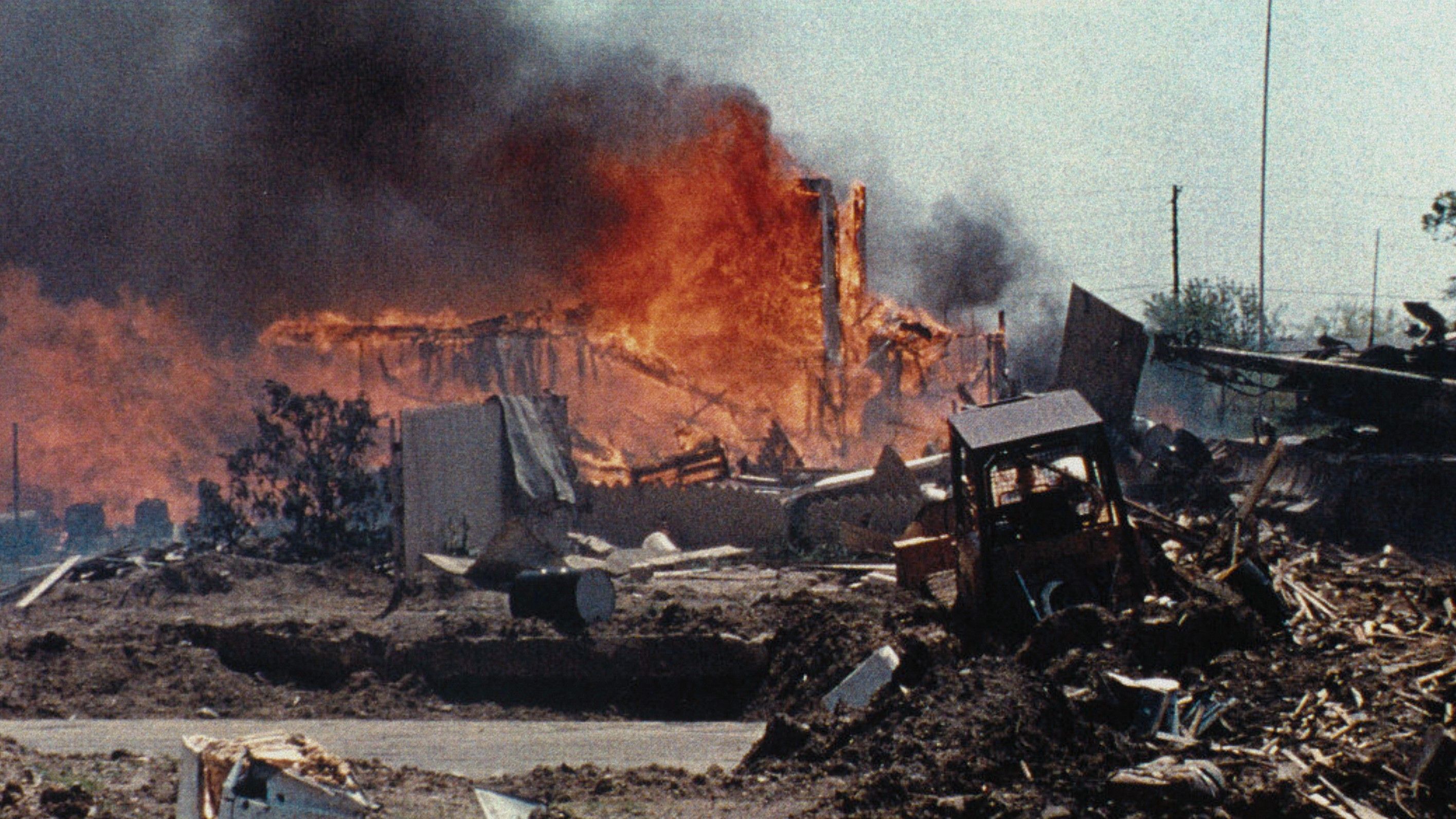Netflix's latest limited docuseries, Waco: American Apocalypse, follows the events that transpired within a compound at Mount Carmel in Waco, Texas for 51 days before a massive fire forced the bloodshed and mystery to stop through an apocalyptic tragedy. Nearly 30 years since the 51-day standoff between federal government authorities and the Branch Davidians, a religious cult led by a man named David Koresh, Netflix's latest series tries to put out testimonies from participants on both sides without falling into the debate of evidence or hard facts. Showcasing exclusive footage from what turned out to be a bloody siege, Waco: American Apocalypse presents differing perspectives of the same events as law enforcement, media personnel, and survivors offer a version of the infamous siege at Waco that they believe to be true.
Beginning on Feb. 28, 1993 and ending on April 19, 1993, the Waco siege resulted in the deaths of four federal officers and 82 Branch Davidians, including 28 children. While various parties differ on what actually transpired at Mount Carmel to result in such a dreadful outcome, there are a few facts that more or less everybody agrees on. Without delving into the morality of the choices that led to the outcome, the Netflix docuseries transfers its focus to the human tragedy that played out live on television as it happened and shocked the entire nation.
David Koresh's Rise to Power Started With a Siege
The Branch Davidians were founded by Benjamin Roden in 1955 as a new religious movement. The Branch Davidians sprung from the Davidians, who were led by a Bulgarian immigrant named Victor Houteff. Upon Victor's death, his wife Florence took the leadership of the Davidians who were based out of their headquarters at Mount Carmel in Waco. When an apocalyptic prophecy anticipated by Florence did not come about, Benjamin Roden separated to form the Branch Davidians. The Branch Davidians placed their beliefs in the literal translation of the Bible and awaited the apocalypse as prophesied in the book. The Branch Davidians took control of the Davidian compound at Mount Carmel.
After Benjamin's death, the reign fell into the hands of Lois, Benjamin's wife. David Koresh was born Vernon Wayne Howell in 1959. He joined the Branch Davidians in 1981 and quickly found favor among the group's members. His relationship with Lois brought him in direct competition with Benjamin and Lois' son, George Roden, for the leadership of the group. As things go in religious cults, Roden challenged Koresh with resurrecting a dead body to prove his miraculous abilities as claimed by Koresh. Opposite to what was expected by Roden, Koresh tried to report Roden's action of exhuming a body to the police and returned to Mount Carmel, which fell into the hands of Roden after Lois' death.
In the November of 1987, the first siege at Waco took place between David Koresh and George Roden when Roden intercepted Koresh's attempts of entering the compound and gathering evidence to lock Roden up in a bid to yield control of Mount Carmel. A massive exchange of bullets took place before law enforcement finally arrived and apprehended the involved men. Interestingly, Koresh walked out of the entire mess as a free man while Roden was jailed for contempt of court. Accordingly, the stage was set for Koresh to take control of the Branch Davidians.
Koresh Used Faith to Influence His Followers
Koresh claimed to be the final prophet, the "Messiah," who has come to help the group survive the apocalypse destined to arrive at their doorsteps any day. He used the writings of the Book of Revelation to further build his image as the prophet of the Branch Davidians. As mentioned in the Netflix docuseries, Koresh also mandated his male followers refrain from having sexual relations with their partners as he chose wives among the women of the group to produce children who would go on to lead the group in the future. In the docuseries, one of the survivors, Kathy Schroeder, even mentions the act of sexual involvement with Koresh as a means to be with her God. However, the more worrying aspect about the group's conduct remains that kids as young as 12 years old were made to have sexual relations with Koresh.
Branch Davidians Had a Huge Stockpile of Firearms
The Branch Davidians dealt guns and firearms legally, thereby explaining the group's easy access to guns. The ATF (the Bureau of Alcohol, Tobacco, Firearms and Explosives) was already keeping surveillance on the group months before the siege took place. The ATF had also managed to place an undercover agent, Robert Rodriguez, within the cult. A day after a local newspaper published a report on the stockpiling of guns and the rampant child abuse among the Branch Davidians, the ATF decided to execute a search warrant at Mount Carmel on February 28, 1993
Unfortunately, the ATF's attempts of conducting a surprise raid did not yield the desired result as the group was tipped off about the raid. A photographer had mistakenly informed a local mail carrier, a member of the group, about the expected raid. With not much left to do, the ATF then decided to proceed with the raid without giving the Branch Davidians much time to think about their next steps.
ATF Raid on Mount Carmel at Waco Was Doomed From Day 1
On receiving the news of the raid, the Branch Davidians decided to ready themselves for the worst, and they set up their defense to face any eventuality. The ATF also readied themselves to conduct the raid with as least resistance as possible. Apparently, Koresh wanted to talk it out with the ATF at first, as per one of the interviewees in the Netflix docuseries. But when gunfire was heard from the other side, all hell broke loose at Waco as the ATF and the Branch Davidians unleashed their firepower at each other. The details of who took the first shot remain unclear to this day, as each group transfers the blame to the other.
By the end of the first day of what turned out to be a siege, four ATF agents and six Branch Davidians were dead, with many others injured. The devastating loss of human life at Waco forced the FBI into action. The FBI's negotiations with Koresh saw varying results with a few women and children being released intermittently at various stages during the 51-day standoff. Koresh's demand for a video of him to be broadcasted on television was accepted in return for his surrender. Unfortunately, Koresh was quick to go back on his word. Over the next few days, the negotiation continued with multiple members of the Branch Davidians coming out of the compound.
During this entire negotiation saga, one element that stood out was the lack of sync between the FBI's Hostage Rescue Team (HRT) and the negotiators who were regularly in contact with the Branch Davidians, either through Koresh or his deputy, Steve Schneider. As made apparent by the testimonies of the members of the negotiating team in Waco: American Apocalypse, the HRT often acted contrarily to what was suggested by the negotiators, leading to a situation where Koresh had lost trust in the negotiation attempts, which yielded some success with multiple cult members leaving the compound.
FBI Blared Loud Music Outside Koresh's Compound
In all honesty, the FBI was hellbent on making Koresh surrender as early as possible. To do so, the FBI resorted to both directly violent and indirectly violent means. Apart from parading an array of tanks, such as the Bradley tanks and Abrams tanks, and an army of law enforcement officers numbering around nine hundred, the FBI decided to force the Branch Davidians to come out by blaring loud music through speakers fixed outside the compound. From Buddhist sermons to the sound of a rabbit's cries while being slaughtered, all kinds of sounds were directed at the Branch Davidians.
An Apocalyptic Fire Brought the Waco Siege to an End
By April 14, 1993, much of the negotiations between the FBI and Koresh were nearing a dead end as, by now, Koresh had promised to surrender multiple times before going back on his word. On April 14, he revealed that he wanted time to write a manuscript to share holy teachings with the world. By this time, the FBI had decided to approach Attorney General Janet Reno for permission to enter the compound. The FBI had sought permission to use tear gas to force the survivors to surrender without opening fire. The assault by the FBI began as planned on 19th April, but soon, a fire started engulfing the Branch Davidian compound at Mount Carmel. It was expected that the fire would force the members of the group to come out. Nine members were able to escape the fire.
The fire's source remains disputed, with many survivors claiming that the FBI had set the fire. But tapes released later revealed that the Branch Davidians had discussed setting a fire. Multiple listening devices were placed inside the compound over the course of the siege that enabled the FBI to capture such recordings. By the time the flames settled, the compound had leveled, ridden with bullet shells, pages of the bibles, and half-charred dead bodies of the men, women, and children who had died. The autopsy revealed that Koresh and his deputy, Schneider, died of bullet wounds. The whole debacle was broadcasted live on television news as the country witnessed the fateful climax of the 51-day-long siege. According to the interim report submitted to the Deputy Attorney General, some of the members of the group died due to the debris falling on them while the others may have been killed by the members to provide a merciful death.
While some of the key events still remain a topic of hot debate, the Waco Siege resulted in one of the most fateful chapters of modern American history as mistakes were clearly and admittedly made on both sides. Nearly 30 years later, Netflix's Waco: American Apocalypse tries to refresh the memory of an event that shook everyone who witnessed it happening, either on-ground or through a television at their homes. It tries to humanize the parties on both sides as each feel justified in their actions. Although the Netflix docuseries chooses to skip a few details, it presents a just opportunity for members of both sides to present their horrifying retelling of the apocalypse that transpired in Waco in 1993. With Showtime's Waco: The Aftermath slated for release in April, this is not the last time we will be hearing about the tragedy of Waco.




